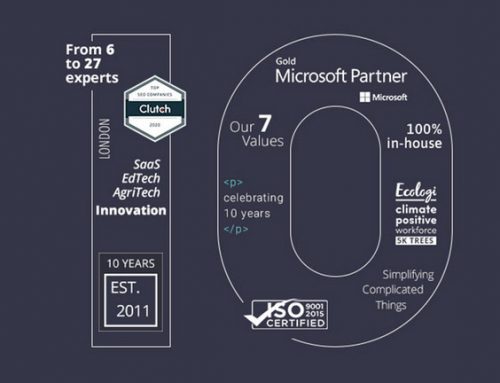We’ve prepared a proposal, pushed the button and design is done – the next phase is where our engineers step in and start to build your software using React.
Now, the reason we use React is that it’s a mature product. Released in 2013, it is established as one of the leading JavaScript frameworks for web development and is widely used by developers worldwide.
We Love JavaScript
React enables our engineers to write their web apps entirely in JavaScript which brings greater functionality than traditional applications. And the great thing is that there’s no corresponding increase in code complexity (you know how we’re dead against making things needlessly complicated).
We break applications into self-contained, easily reusable components. This gives greater clarity and allows us to refactor more easily. Presentational and API logic are decoupled and applications are defined in a declarative style, rather than defining at every point how every part of the application should function. We silo the logic into components and the overall application is then written in terms of what should be displayed at every point in the application’s state.
We Hate Bugs
It’s a more modular approach. It’s not only expressive, it also leads to quicker development and less bug-prone code. The result is that you end up with a simpler, cleaner piece of software.
Virtual DOM
React’s other main innovation is the Virtual DOM. We’ll explain. Web browsers render web pages intrinsically slowly and it requires heavy graphical processing. So, making changes to the DOM (the browser’s logical representation of the page) has always been one of the slowest processes in a web app’s lifecycle. Why? Because it waits for the entire page to update after every individual change.
With Virtual DOM, React calculates what the DOM’s state will be after any updates are made by the app. It then compares this state to the previous state. It then finds the differences between the old and new state and works out the minimum amount of changes it needs to make to transform it from the old to new state. It then simply transmits that information to the browser which then updates the page, minimising the amount of physical rendering the browser must do. This also maximises the responsiveness of you app.
React UI Sign-Offs
Next, our internal testing team thoroughly check the React User Interface against the stories agreed in the proposal. We use a User Acceptance Testing (UAT) spreadsheet and mark each completed user story as ‘Approved by AVAMAE’.
We then present you with the React UI to review as each module is complete and signed off by AVAMAE. Once you’ve examined our work thoroughly, if you’ve any issues, raise them and we’ll resolve them. Once every module has been approved, we take that as your final sign-off.
Back-end Dev
Now React has taken care of how your app looks and feels, we focus on what it actually does – your data and business logic. Our back-end engineers use a combo of ASP.NET Core and SQL Server – two of the most popular server-side technologies.
ASP.NET Core is a cross-platform app framework written in C#. It’s great as it performs really well on Linux, Mac and Windows on-premises servers or in the cloud. It’s this extra flexibility that means you’re never tied to one platform. The .NET core framework isn’t just for web apps either, as the same code can be shared between web, desktop and mobile apps – even video games. This slashes development time as our team doesn’t need to keep reinventing the wheel as your business grows.
ASP.NET Core also easily integrates with container technologies such as Docker. This makes your app truly portable and scalable. Using the power of Docker and Kubernetes, we can design your app to run smoothly at any scale you need from launch.
We find SQL Server to be a really powerful and stable way to manage app data. In the hands of our expert Microsoft certified engineers, we can make your data work for you with real speed and efficiency.
Final Sign-off
It’s then back to our internal testing team to check the fully developed site against the user stories in the agreed proposal and signed-off prototype. Again, we mark approved stories as Approved by AVAMAE on our UAT spreadsheet and pass it on to the client a module at a time.
Final testing is incredibly thorough and covers every aspect of the software. We test across Google Chrome, Edge, IE, Firefox, Safari and Opera as well as on the operating system they were built for, i.e., iOS App on iPhone and iPad. We also test accessibility against W3C AA Standards.
Finally, it’s over to the client for final testing and sign-off using stories and the UAT spreadsheet. We require you to complete testing and the UAT spreadsheet within 10 days of receiving it. No news is good news as we assume if we haven’t heard anything, we have your approval and the module is signed off.
If you can’t sign off a user story, you need to let us know why. We can then check and rectify any problems. This only applies to bugs as any functionality additional to the user stories agreed at the design stage is out of the scope of the project. Any fixes needed will be rectified within 7 days and we give you 7 days to check these. If we don’t hear anything, we assume your approval.
Once all modules are signed off, that is final project sign-off. We’ll then invoice you for payment within 7 days and we’ll only make your site or app live once payment is received.
Let’s Talk
So, that’s Better Building ‘The AVAMAE Way’. It’s thorough, organised and is designed to stamp out bugs and deliver cleaner, simpler code. Got a project in mind? Simply call +44 (0) 20 7509 6992 or email robert.mcewan@avamae.co.uk and we can meet for a chat.



